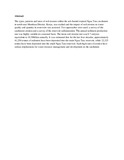| dc.contributor.author | Kitheka, J U | |
| dc.contributor.author | Gichuki, F N | |
| dc.contributor.author | Mungai, D N | |
| dc.contributor.author | Gachene, C K K | |
| dc.contributor.author | Thomas, D B | |
| dc.date.accessioned | 2014-08-06T12:58:04Z | |
| dc.date.available | 2014-08-06T12:58:04Z | |
| dc.date.issued | 2000 | |
| dc.identifier.citation | Kitheka, J. U., Gichuki, F. N., Mungai, D. N., Gachene, C. K. K., & Thomas, D. B. (2000). Soil erosion and reservoir sedimentation: a case study of Nguu Tatu catchment. In Land and water management in Kenya: towards sustainable land use. Proceedings of the Fourth National Workshop, Kikuyu, Kenya, 15-19 February, 1993. (pp. 55-60). Soil and Water Conservation Branch, Ministry of Agriculture and Rural Development. | en_US |
| dc.identifier.uri | http://hdl.handle.net/11295/73699 | |
| dc.description.abstract | The types, patterns and rates of soil erosion within the sub-humid tropical Nguu Tatu catchment in north-east Mombasa District, Kenya, was studied and the impact of soil erosion on water quality and quantity in reservoirs was assessed. Two approaches were used: a survey of the catchment erosion and a survey of the reservoir sedimentation. The annual sediment production rate was highly variable n a seasonal basis. The mean soil erosion rate was 0.7 cm/year, equivalent to 10,500t/km annually. It was estimated that for the last four decades, approximately 41,250 tonnes of sediment have been deposited into the main Nguu Tatu reservoir, while 22,325 tonnes have been deposited into the small Nguu Tatu reservoir. Such high rates of erosion have serious implications for water resource management and development in the catchment. | en_US |
| dc.language.iso | en | en_US |
| dc.publisher | University Of Nairobi | en_US |
| dc.title | Soil erosion and reservoir sedimentation: a case study of Nguu Tatu catchment. | en_US |
| dc.type | Presentation | en_US |
| dc.type.material | en | en_US |

